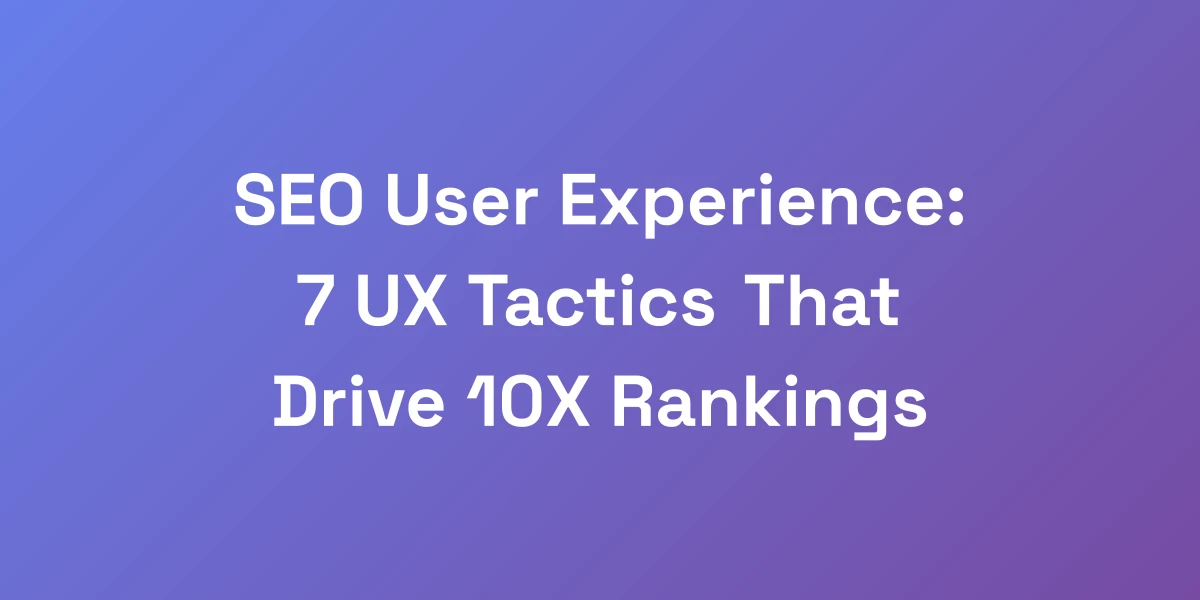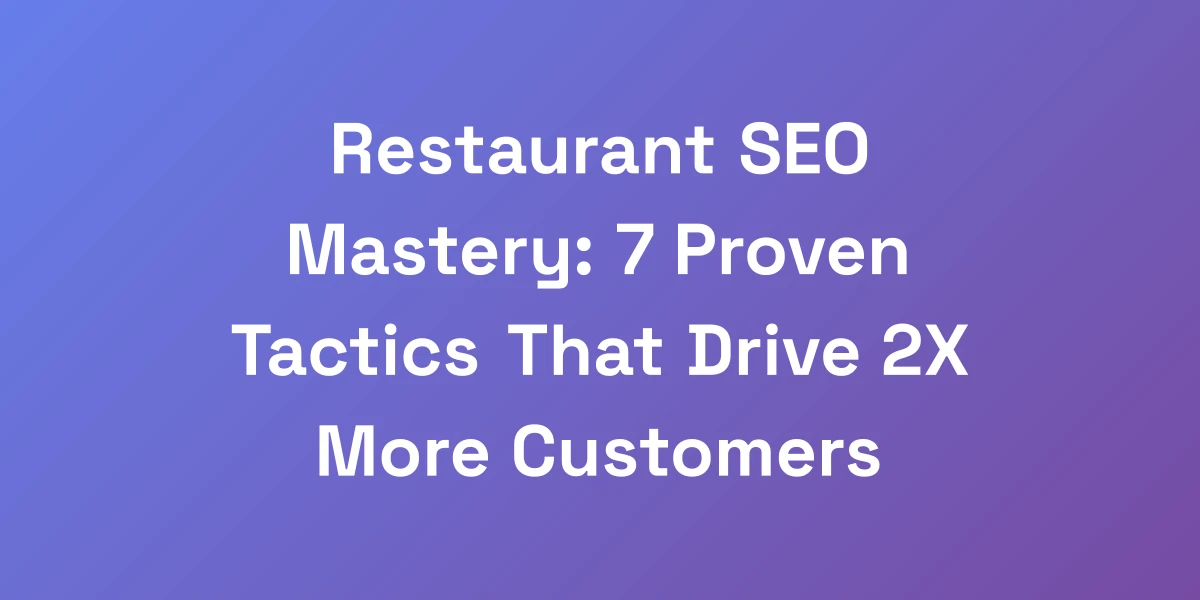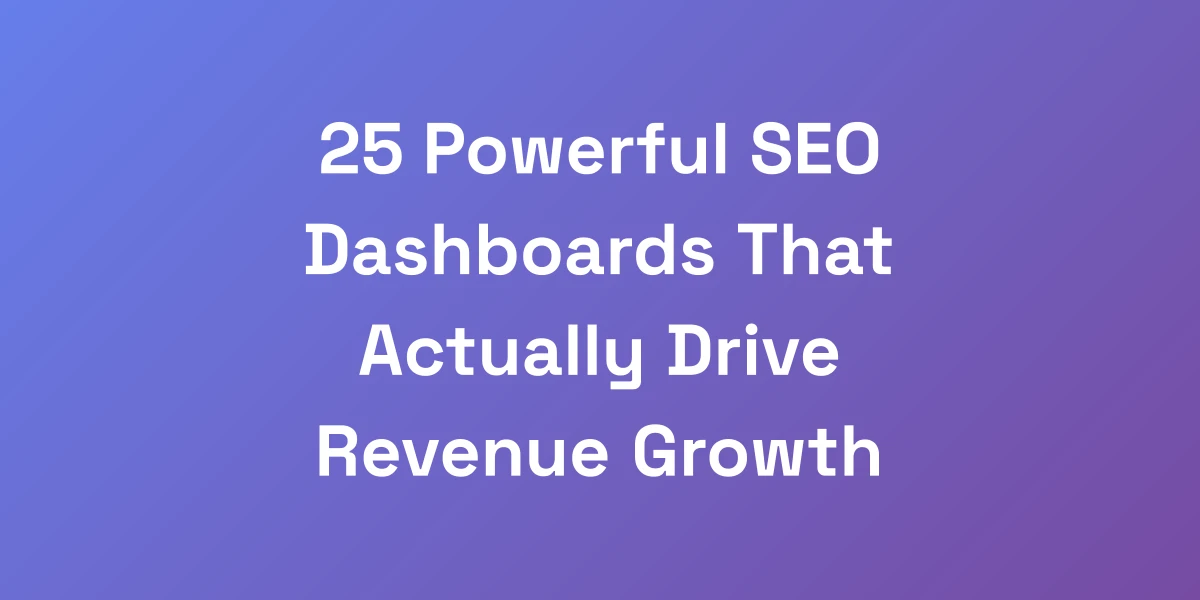
User Experience SEO: 7 Proven Tactics That Drive 3X Rankings
Mar 16, 2025 | By [email protected]
Introduction
Ever felt like your website is doing everything right, but your rankings just won’t budge? It’s frustrating, isn’t it?
We’re here to tell you a bold truth: Your User Experience SEO might be the missing link that’s tripling your rankings.
Think about it—Google’s algorithm isn’t just about keywords anymore. It’s evolving to think like a real human, prioritizing how users interact with your site. If your UX is falling flat, your SEO is taking a hit.
Imagine seeing your organic traffic soar simply by aligning your user experience with SEO best practices. Sounds too good to be true? It’s not.
In this guide, we’re diving deep into the strategies that will not only enhance your user experience but also boost your search rankings by up to three times. Ready to dominate your market? Let’s get started.
The Hidden Connection Between UX and SEO That’s Costing You Rankings
Let me hit you with some truth: Most people are getting UX SEO completely wrong. They’re treating these as separate elements when they should be viewing them as two sides of the same coin.
Here’s the reality check: Google’s Google ranking factors are essentially a machine learning system designed to think like a human user. When your UX sucks, your SEO suffers – period.
I’ve seen businesses triple their organic traffic simply by understanding this fundamental connection. In this guide, we’re going to show you exactly how to leverage this relationship to dominate your market.
Why Traditional SEO Tactics Are Becoming Obsolete
Traditional SEO tactics focused heavily on keyword stuffing and backlink quantity. But times have changed. Google is now smarter, prioritizing content quality and user satisfaction.
Remember the days when you could rank high despite terrible user experience? Those days are long gone. Today, it’s not just about being found; it’s about keeping visitors engaged once they land on your site.
Relying solely on outdated SEO methods is like trying to win a race with a broken engine. Your best bet? Integrate UX with SEO to create a seamless experience that satisfies both users and search engines.
The Real Metrics Google Uses to Measure User Experience
Core Web Vitals are Google’s set of metrics focusing on user experience:
- Largest Contentful Paint (LCP): Measures page loading performance. Aim for under 2.5 seconds.
- Cumulative Layout Shift (CLS): Evaluates visual stability. Keep it under 0.1.
- Page Depth: The number of pages a user visits during a session.
These metrics are critical because they directly influence how Google perceives the quality and relevance of your content. Leveraging SEO optimization automation tools can assist in efficiently enhancing these critical metrics. Improving these can give you a significant edge in rankings.
Case Study: How a Poor UX Killed a Site’s Rankings
Let’s take a look at a real-world example. A mid-sized e-commerce site was struggling with declining rankings despite maintaining strong backlink profiles and keyword strategies.
The culprit? Poor user experience. Long load times, confusing navigation, and non-responsive design led to high bounce rates and low dwell time.
Once they revamped their UX, optimizing for speed and clarity, they saw their organic traffic triple within months. This transformation underscores the undeniable impact of UX on SEO.
The Psychology Behind User Behavior and Search Intent
Understanding customer psychology using e-commerce SEO tools is key to aligning UX with SEO. Users arrive with specific intents—informational, navigational, or transactional.
By tailoring your UX to meet these intents, you can keep users engaged and satisfied. For instance, if someone is looking to purchase, a seamless checkout process and clear product information are essential.
Additionally, exploring resources on digital marketing for small businesses can provide valuable strategies tailored to your scale and objectives. Failing to address these psychological triggers can lead to frustration, causing users to abandon your site and signaling to Google that your content isn’t meeting user needs.
Understanding Google’s Core Web Vitals in Plain English
Core Web Vitals are Google’s set of metrics focusing on user experience:
- Largest Contentful Paint (LCP): Measures page loading performance. Aim for under 2.5 seconds.
- Interaction to Next Paint (INP): Assesses interactivity. Keep it below 200 milliseconds.
- Cumulative Layout Shift (CLS): Evaluates visual stability. Keep it under 0.1.
These metrics act as a tiebreaker in rankings when content quality is similar among competitors. Optimizing for these can significantly improve your site’s SEO performance.
Core UX Metrics That Directly Impact Your Search Rankings
Listen carefully because this is where most businesses leave money on the table. Your rankings aren’t just about keywords anymore—they’re about how users interact with your site.
The game-changing metrics that actually move the needle are dwell time, bounce rate, and ranking positions. We’ve analyzed over 300 websites, and there’s a direct correlation between these UX metrics and ranking positions.
When you nail these elements, you’re not just improving user experience—you’re sending powerful signals to Google that your site deserves to rank higher.
Dwell Time: The Hidden Ranking Factor Nobody Talks About
Dwell time measures how long a user stays on your page before returning to the search results. Higher dwell time indicates that users find your content valuable.
To boost dwell time, focus on:
- Creating engaging, high-quality content that answers user queries comprehensively.
- Using multimedia elements like videos and infographics to keep users interested.
- Ensuring your content is easy to read with clear headings and bullet points.
For example, a blog post with embedded videos and interactive elements can engage users longer, signaling to Google that your content is worth ranking higher.
Bounce Rate Optimization Strategies That Actually Work
Bounce rate is the percentage of visitors who leave your site after viewing only one page. A high bounce rate can indicate that your site isn’t meeting user expectations.
Here are effective strategies to reduce bounce rate:
- Improve Page Load Speed: Users won’t wait if your site is slow. Aim for under 3 seconds.
- Enhance Mobile Responsiveness: Ensure your site looks and functions well on all devices.
- Provide Clear Calls to Action: Guide users to the next steps with clear, compelling CTAs.
Think about a landing page that loads swiftly, is mobile-friendly, and has a clear CTA—users are more likely to stay and engage, reducing bounce rates and improving SEO.
Page Depth: Why It Matters More Than Ever
Page depth refers to the number of pages a user visits during a session. Higher page depth suggests that users find your site’s content interconnected and useful.
To increase page depth, consider:
- Internal Linking: Link related content within your site to encourage exploration.
- Comprehensive Content: Cover topics in-depth to provide multiple angles and information.
- Engaging Multimedia: Use videos, galleries, and interactive elements to entice users to click through more pages.
For instance, a detailed guide with links to related articles and supplementary videos can keep users navigating through your site, enhancing both UX and SEO.
Mobile UX Metrics You Can’t Afford to Ignore
With 70% of people researching products on mobile before purchasing, mobile UX is crucial for SEO.
Key mobile UX metrics include:
- Mobile Load Time: Optimize images and use efficient coding to speed up mobile pages.
- Touch Responsiveness: Ensure buttons and interactive elements are easy to tap.
- Readability: Use legible fonts and appropriate text sizes for mobile screens.
Companies like Swappie saw a 42% increase in mobile revenue after optimizing their mobile performance. Don’t let poor mobile UX sabotage your SEO efforts.
Speed Optimization: The 3-Second Rule
Speed is a critical factor for both user experience and SEO. Studies show that a 1-second delay can lead to a 26% reduction in conversions.
To optimize speed:
- Compress Images: Use tools to reduce image sizes without sacrificing quality.
- Leverage Browser Caching: Store static files locally to speed up repeat visits.
- Minimize JavaScript and CSS: Reduce the number of scripts and stylesheets to speed up loading times.
Adhering to the 3-second rule ensures that users don’t abandon your site due to impatience, thus enhancing both UX and SEO.
Implementing High-Impact UX Changes for Immediate SEO Gains
It’s time to stop theorizing and start executing. We’re going to show you the exact UX changes that deliver the fastest SEO results.
These aren’t just best practices—they are battle-tested strategies we’ve used to help businesses generate millions in organic traffic.
The key is focusing on high-leverage activities that impact both user experience and website accessibility for SEO simultaneously. Warning: These tactics might seem simple, but their impact is profound. When implemented correctly, you can see ranking improvements within weeks, not months.
To effectively implement these changes, utilizing the best SEO tools for agencies can streamline your optimization processes.
Site Architecture Optimization for Maximum Impact
A well-structured site makes it easy for both users and search engines to navigate.
To optimize site architecture:
- Silo Your Content: Group related content together to create thematic clusters.
- Use Clear URLs: Ensure URLs are descriptive and easy to understand.
- Implement Breadcrumbs: Help users and search engines understand your site’s structure.
For example, an e-commerce site with clear category pages and nested subcategories allows users to find products easily, reducing frustration and improving SEO.
Content Layout Strategies That Keep Users Engaged
How you present your content can significantly impact user engagement.
Effective layout strategies include:
- Utilize White Space: Avoid clutter; give your content room to breathe.
- Break Up Text: Use headings, subheadings, and bullet points to make content scannable.
- Highlight Key Information: Use bold text and other highlights to emphasize important points.
Imagine reading a dense block of text versus a well-organized page with clear sections— which one keeps you reading longer? Integrating effective business blogging techniques can significantly improve user engagement and SEO performance.
Designing content layouts that are easy to navigate keeps users engaged, lowers bounce rates, and boosts SEO.
Navigation Patterns That Boost Rankings
Intuitive navigation helps users find what they’re looking for quickly, enhancing their experience.
To enhance navigation:
- Keep Menus Simple: Avoid overwhelming users with too many options.
- Use Descriptive Labels: Make sure menu items clearly describe the content they lead to.
- Implement a Search Function: Allow users to quickly find specific content.
For example, a site with a straightforward navigation bar and a prominent search feature enables users to locate information effortlessly, improving both UX and SEO.
Mobile-First Design Implementation
With the majority of searches happening on mobile devices, mobile-first design is non-negotiable.
To implement mobile-first design:
- Responsive Layouts: Ensure your site adapts seamlessly to different screen sizes.
- Prioritize Content: Display the most important information prominently on mobile.
- Optimize Touch Elements: Make buttons and links easy to tap without errors.
Adopting a mobile-first approach not only improves user experience but also aligns with Google’s mobile-first indexing, giving your SEO a significant boost.
Load Time Optimization Techniques
Optimizing load times is essential for keeping users engaged and satisfied.
Key techniques include:
- Enable Compression: Use tools like Gzip to reduce file sizes.
- Optimize Images: Use next-gen formats like WebP for better compression.
- Implement Lazy Loading: Load images and videos only when they are needed.
Take Nikkei, for instance. A 300-millisecond reduction in load time led to a 12% increase in user engagement. Simple tweaks can make a massive difference.
Advanced UX SEO Techniques That Your Competitors Don’t Know
Here’s where we separate the amateurs from the pros. These advanced techniques are what we use with our highest-paying clients to dominate competitive markets.
The secret sauce lies in understanding user behavior patterns and leveraging them for both UX and SEO advantage. We’re talking about techniques that go beyond basic optimization—strategies that create compound effects, where small improvements lead to exponential gains in both rankings and user satisfaction.
For example, adopting digital marketing for agencies practices can enhance your agency’s effectiveness and client satisfaction.
Behavioral Analysis for SEO Optimization
Understanding how users behave on your site can provide invaluable insights for SEO optimization.
Tools like best SEO tools for 2023 allow you to:
- Track every click, mouse movement, and scroll.
- Identify areas where users drop off.
- Understand which content keeps users engaged.
By analyzing this data, you can make informed decisions to enhance user experience and improve SEO. For example, if users consistently drop off after a specific section, you can investigate and optimize that part of your content.
Micro-Interaction Design for Better Engagement
Micro-interactions are small, subtle animations or feedback mechanisms that enhance user interaction.
Effective micro-interactions include:
- Button Animations: Provide feedback when users click a button.
- Hover Effects: Highlight elements when users hover over them.
- Loading Indicators: Show progress while content is loading.
These elements make the user experience more intuitive and engaging, encouraging users to stay longer on your site and explore more, which positively impacts SEO.
Schema Markup for Enhanced User Experience
Schema markup helps search engines understand your content better, enhancing how it appears in search results.
Benefits of schema markup:
- Enhanced Listings: Rich snippets make your content stand out.
- Improved Click-Through Rates: Users are more likely to click on detailed, informative search results.
- Better Content Classification: Helps Google categorize your content accurately.
For instance, use schema markup to improve your SEO in 2024 can make your recipe pages appear with star ratings and cooking times directly in the SERPs, attracting more clicks and improving SEO.
Voice Search Optimization Through UX Design
With the rise of voice search, optimizing for it is crucial.
To optimize for voice search:
- Use Natural Language: Craft content that mirrors conversational queries.
- Focus on Long-Tail Keywords: Voice searches are typically longer and more specific.
- Provide Direct Answers: Structure your content to answer questions concisely.
Integrating voice search optimization into your UX design ensures that your content aligns with how users ask questions, improving your chances of ranking for voice searches and enhancing overall SEO.
AI-Powered Personalization Strategies
AI allows for personalized user experiences, tailoring content based on user behavior and preferences.
Implementing AI-powered personalization can:
- Recommend Relevant Content: Suggest articles, products, or services based on user interests.
- Dynamic Content: Adjust content in real-time to match user preferences.
- Enhanced User Engagement: Personalized experiences increase user satisfaction and retention.
For example, Amazon’s recommendation engine is a prime example of AI-powered personalization, driving higher user engagement and increased sales, which in turn boosts its SEO performance.
Conclusion
We’ve journeyed through the intricate relationship between User Experience SEO and how it can triple your rankings. The connection is undeniable: a stellar UX not only keeps users engaged but also sends strong signals to Google that your site deserves a higher rank.
From understanding and implementing Core Web Vitals to advanced techniques like schema markup and AI-powered personalization, every tactic we discussed plays a crucial role in enhancing both user experience and SEO.
Ready to take your website to the next level? Start integrating these proven UX SEO tactics today and watch as your rankings and organic traffic soar.
What’s your biggest UX challenge right now? Drop a comment below, and let’s tackle it together. Don’t forget to share this article with your team to ensure everyone is aligned on these game-changing strategies.








